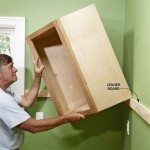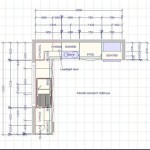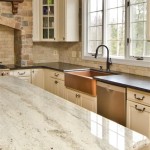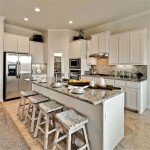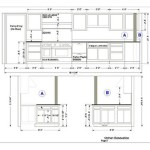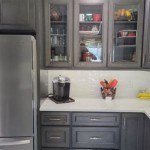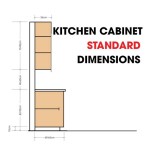Kitchen Cabinet Hutch: A Comprehensive Guide
The kitchen cabinet hutch is a versatile and functional piece of furniture designed to enhance storage and display capabilities within the kitchen space. It is generally characterized by a combination of enclosed cabinets, open shelving, and sometimes drawers, offering a diverse range of storage solutions. Understanding the nuances of a kitchen cabinet hutch – its components, styles, materials, and installation considerations – is crucial for homeowners seeking to incorporate this valuable addition into their kitchen design.
The purpose of a kitchen cabinet hutch extends beyond mere storage. It serves as a focal point, contributing to the overall aesthetic appeal of the kitchen. Hutch designs can range from traditional to contemporary, allowing homeowners to select a style that complements their existing décor. The display shelves provide an opportunity to showcase cherished dishware, decorative items, or cookbooks, adding a personal touch to the kitchen environment.
A kitchen cabinet hutch typically consists of two main sections: a base cabinet and an upper cabinet. The base cabinet usually sits directly on the floor and provides enclosed storage space behind doors. This section is often used for storing larger items such as pots, pans, or small appliances. Drawers may also be incorporated into the base cabinet to provide convenient storage for utensils, linens, or other frequently used items. The upper cabinet is placed on top of the base cabinet and typically features a combination of enclosed cabinets and open shelves. The open shelves are ideal for displaying items, while the enclosed cabinets offer concealed storage for dishes, glassware, or pantry staples.
The size and configuration of a kitchen cabinet hutch can be customized to fit the specific needs and dimensions of a particular kitchen. Smaller hutches may be suitable for apartments or kitchens with limited space, while larger hutches can provide ample storage and display space in larger kitchens. The depth of the shelves and cabinets can also be adjusted to accommodate different types of items. In addition, some hutches may include features such as built-in lighting, wine racks, or spice racks to further enhance their functionality.
Key Point 1: Materials and Construction
The quality and durability of a kitchen cabinet hutch are heavily influenced by the materials used in its construction. A variety of materials are commonly employed, each possessing unique characteristics in terms of strength, aesthetics, and cost. Understanding these material properties is essential for making informed decisions about the selection of a kitchen cabinet hutch.
Hardwood is a popular choice for kitchen cabinet hutches due to its strength, durability, and natural beauty. Common hardwood species used in hutch construction include maple, oak, cherry, and walnut. Each of these woods possesses distinct grain patterns and color variations, allowing homeowners to choose a wood that complements their overall kitchen design. Hardwood is typically more expensive than other materials, but its longevity and timeless appeal make it a worthwhile investment for many homeowners.
Softwood, such as pine, is a more affordable alternative to hardwood. While not as durable as hardwood, softwood can still provide adequate support for a kitchen cabinet hutch. Pine is often used in rustic or country-style kitchens due to its knotty grain and warm color. Softwood is less resistant to scratches and dents than hardwood, so it may require more frequent maintenance and refinishing.
Plywood is an engineered wood product that is made by bonding together multiple layers of wood veneer. It is a strong and stable material that is less prone to warping or cracking than solid wood. Plywood is often used for the construction of cabinet boxes and shelves. It can be stained or painted to match the overall design of the kitchen.
Medium-density fiberboard (MDF) is another engineered wood product that is made from wood fibers that are bonded together with resin. It is a smooth and uniform material that is ideal for painting or laminating. MDF is often used for cabinet doors and drawer fronts. It is less resistant to moisture than solid wood or plywood, so it is important to protect it from water damage.
The construction methods used in building a kitchen cabinet hutch also play a significant role in its overall quality and durability. Dovetail joints are a strong and durable type of joint that is often used to connect the sides of drawers. Mortise and tenon joints are another type of strong joint that is used to connect the frame of the cabinet. Screw and glue construction is a common method for assembling cabinet boxes. The quality of the hardware, such as hinges and drawer slides, is also important. High-quality hardware will ensure that the doors and drawers operate smoothly and reliably for many years.
Key Point 2: Styles and Designs
Kitchen cabinet hutches are available in a wide range of styles and designs to complement any kitchen décor. From traditional to contemporary, there is a hutch to suit every taste. The style of a hutch is determined by its overall design, including the shape of the doors and drawers, the type of hardware used, and the finish applied to the wood. Understanding the different styles of kitchen cabinet hutches can help homeowners choose a hutch that perfectly complements their existing kitchen design.
Traditional kitchen cabinet hutches are characterized by their ornate details, raised panel doors, and antique-style hardware. These hutches often feature decorative moldings, such as crown molding and base molding. Traditional hutches are typically made from hardwood, such as cherry or maple, and finished with a rich stain or paint. The overall look of a traditional hutch is elegant and timeless.
Contemporary kitchen cabinet hutches are characterized by their clean lines, minimalist design, and modern hardware. These hutches often feature flat panel doors, frameless construction, and stainless steel or brushed nickel hardware. Contemporary hutches are typically made from materials such as MDF or plywood, and finished with a sleek paint or laminate. The overall look of a contemporary hutch is modern and sophisticated.
Farmhouse kitchen cabinet hutches are characterized by their rustic charm, distressed finishes, and simple designs. These hutches often feature beadboard panels, open shelving, and vintage-style hardware. Farmhouse hutches are typically made from wood, such as pine or reclaimed wood, and finished with a distressed paint or stain. The overall look of a farmhouse hutch is cozy and inviting.
Transitional kitchen cabinet hutches blend elements of both traditional and contemporary styles. These hutches often feature clean lines, simple details, and a mix of materials. Transitional hutches can be made from a variety of woods and finished with a range of paints or stains. The overall look of a transitional hutch is balanced and versatile.
In addition to the overall style, the design of the hutch can also vary. Some hutches feature a single upper cabinet, while others have multiple cabinets and shelves. Some hutches have drawers, while others have only doors. The design of the hutch should be chosen based on the specific storage and display needs of the homeowner.
Key Point 3: Installation and Placement Considerations
Proper installation and placement of a kitchen cabinet hutch are essential for ensuring its stability, functionality, and aesthetic appeal. The installation process typically involves assembling the hutch, attaching it to the wall, and leveling it. The placement of the hutch should be carefully considered to ensure that it does not obstruct traffic flow or interfere with other kitchen appliances.
Before installing a kitchen cabinet hutch, it is important to ensure that the floor is level and that the wall is strong enough to support the weight of the hutch. If the floor is not level, shims can be used to level the hutch. If the wall is not strong enough, additional support may be required. It is also important to locate the wall studs before attaching the hutch to the wall. Screws should be driven into the wall studs to provide secure attachment.
The placement of the hutch should be carefully considered to maximize its functionality and aesthetic appeal. The hutch should be placed in a location that is easily accessible and does not obstruct traffic flow. It should also be placed in a location that is visually appealing and complements the overall design of the kitchen. The hutch should not be placed too close to the stove or sink, as it may be exposed to heat and moisture.
The size of the hutch should also be considered when determining its placement. A large hutch may overwhelm a small kitchen, while a small hutch may get lost in a large kitchen. The size of the hutch should be proportional to the size of the kitchen.
In some cases, it may be necessary to hire a professional contractor to install a kitchen cabinet hutch. This is especially true if the installation requires modifications to the existing electrical or plumbing systems. A professional contractor can ensure that the hutch is installed safely and correctly.
Finally, consider the lighting around the hutch. If the hutch features open shelving, proper lighting can enhance the display of items and create a more visually appealing focal point. Under-cabinet lighting or spotlights can be used to illuminate the shelves and highlight the items on display.
:strip_icc()/102121052-d7652904743342879fa602cd04dde9dc.jpg?strip=all)
Kitchen Hutch Ideas

Top Cabinetry Trends Kitchen Green Cabinets Furniture Makeover

Need More Kitchen Storage Consider Hutch Style Cabinets

How We Turned Our Built In Kitchen Desk To A Hutch Kinsey Walsh

6 Popular Kitchen Hutch Designs And Ideas That You Need To Know Decor Cabinets

Dining Room Buffet With Hutch Kreg Tool

Farmhouse Country Cottage Rustic Kitchen Hutch Cabinet Storage Buffet China Breakfront

Tips For Styling Organizing Your Kitchen Hutch Cabinets Amy E Peters

Hitow Kitchen Hutch Sideboard Buffet Pantry Storage Cabinet 74 8 H Walnut Com

Need More Kitchen Storage Consider Hutch Style Cabinets
Related Posts

